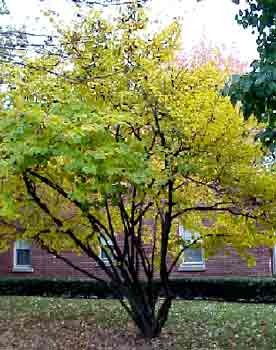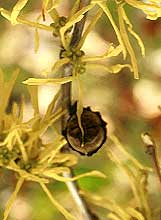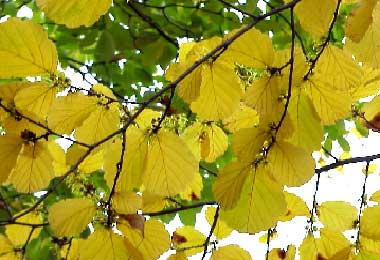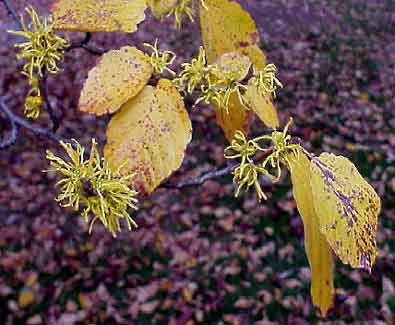 Common Witchhazel - Hamamelis virginiana
Common Witchhazel - Hamamelis virginiana
Witchhazel Family (Hamamelidaceae)
Introduction: This native large shrub or small tree offers attractive yellow foliage and fragrant flowers in fall. It is an excellent plant for naturalized settings.
 Additional information:
Additional information:
The common name witchhazel comes from an old English word that means "to bend." European species of Hamamelis were once used as divining rods to search for water. Witchhazel bark has been mixed with water and alcohol to make an astringent for sores and bruises. Tannins found in the bark have also been used to treat hemorrhoids and in eye medications. Witchhazel extract has been used in after-shave lotion. The bark of witchhazel is light brown and thin. It peels off to reveal a reddish purple inner bark.
Culture: Common witchhazel performs best in moist soils in full sun or shade. It prefers soils that are slightly acidic or neutral, as it is not as tolerant of high pH as Hamamelis vernalis. Common witchhazel is hardy in Zones 3 to 8, possibly 9. Common witchhazel has no serious disease or insect problems, although it may develop galls on the bottom of its leaves if planted near birch trees.
- Native habitat: Canada south to Georgia, west to Arkansas and Nebraska.
- Growth habit: Large shrub or small tree with large, spreading branches that form a rounded crown.
- Tree size: 20 to 30 feet tall with a 15- to 20-foot spread.
- Flower and fruit: Flowers are fragrant and have four yellow, ribbon-like petals. Flowers are borne in November and are effective for 2 to 4 weeks. Fruit is a ½-inch-long capsule. Seeds are discharged one year after flowering.
 Leaf: Alternate, simple leaves are 3 to 6 inches long. They are medium green in summer. Fall color is yellow and can be excellent.
Leaf: Alternate, simple leaves are 3 to 6 inches long. They are medium green in summer. Fall color is yellow and can be excellent.- Hardiness: Winter hardy to USDA Zone 3.
 Additional information:
Additional information:The common name witchhazel comes from an old English word that means "to bend." European species of Hamamelis were once used as divining rods to search for water. Witchhazel bark has been mixed with water and alcohol to make an astringent for sores and bruises. Tannins found in the bark have also been used to treat hemorrhoids and in eye medications. Witchhazel extract has been used in after-shave lotion. The bark of witchhazel is light brown and thin. It peels off to reveal a reddish purple inner bark.
Common witchhazel is our native witchhazel and it differs from its Asiatic relatives by flowering in the fall and early winter. The best plants drop their foliage early in the fall to allow a good flower display. The flowers of common witchhazel have four ribbon-like petals and are quite fragrant. The fruit, a capsule, bursts open and shoots seeds up to 12 feet away. This led to another common name for the plant, snapping hazel.


